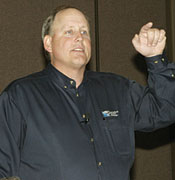
The company is taking its training program through 36 states around the United States and Canada in order to prepare dealers and contractors for the changes coming to the HVAC industry in 2006.
The main change involves the new 13 SEER efficiency standard that takes effect in January 2006. However, ICP also wants to teach its contractors and dealers about R-410A, which many manufacturers are beginning to offer in their cooling equipment. The meetings also include sales training and marketing tools for those who offer Heil, Tempstar, Comfortmaker, Arcoaire, and KeepRite brands.
Well over 100 individuals packed the room for the Phoenix meeting, as contractors and dealers converged to find out the latest on ICP equipment, as well as the changes they're about to face in the HVAC industry.

New Opportunities
ICP president Herman Kling started the meeting by addressing the crowd via video. He stated that there are four main challenges facing contractors in the near future:Kling added that change is inevitable in the HVAC industry, so contractors' success depends on taking advantage of opportunities that will arise to set themselves apart from the competition.
For many, changing to 13-SEER equipment will pose some challenges. Several contractors in the crowd were uneasy about how the new efficiency standard would affect them.
"Right now, we primarily install 10-SEER equipment because we're in an area that mainly has vacation homes," noted one contractor from eastern Arizona. "People here don't really want to pay for higher efficiency, because we're at a higher altitude and don't need a lot of cooling. I don't really know how it's going to impact us yet."
John Teder, ICP's training and communications manager, encouraged contractors to start offering 12-SEER equipment now in order to prepare for the 13-SEER mandate in January. "You don't want to be selling 10 SEER, then overnight go to 13 SEER. Step up to 12 SEER in 2005, so it won't be as big of a jump in 2006."
One contractor from the Tucson area wasn't as concerned with the changeover to 13 SEER. He noted, "We'd have to practice installing 10-SEER equipment. We only install 12 SEER and above, so the changeover just won't be a big deal for us."
Teder noted contractors should have a transition plan in place and that those plans should be communicated to the distributors. "Our plant changes have already begun," stated Teder. "We will be able to get the 13-SEER equipment to you, but it takes a lot of planning. Our ability to support you depends on your input."
Refrigerant Changes
The minimum efficiency standard that takes place in January has increased the need for equipment that utilizes alternative refrigerants. Production levels of R-22 have already been cut, and the equipment using the refrigerant will be phased out in 2010. This has changed the way manufacturers are viewing things. Basically, they're not going to put a lot of research and development into R-22 equipment if they have to phase it out in 2010.The refrigerant chosen to replace R-22 is R-410A. Bob Beym, ICP's technical training instructor, asked the assembled contractors how many had installed equipment that used R-410A. Only a few attendees raised their hands. "Be prepared, because the price of R-22 will most likely keep going up, as it has already," noted Beym. "You will need to know how to handle R-410A sooner than you think."
Many contractors in the audience weren't familiar with R-410A at all, as evidenced by a spirited debate over lunch in which several contractors argued if they'd have to buy new recovery equipment for R-410A. (They will.) It is for reasons like this that the contractors sat in rapt attention during Beym's presentation on R-410A.
According to the saturation table that Beym passed out, R-410A operates at pressures about 60 percent higher than R-22. That means if the evaporator temperature is 46 degrees F, the suction pressure in an R-410A system will be 129.8 psig versus 76.1 psig in an R-22 system.
Because of the higher pressures, contractors will need new gauges. "Go get the gauges now," said Beym. "On the new gauges the high side goes to 800 psig and the low side goes to 500 psig, although 300 psig is the recommended maximum. The manifold must also be more substantial, as well as the tubing, in order to withstand the pressures of R-410A."
Likewise, new high-pressure rated recovery equipment will also have to be purchased before attempting to recover R-410A from a system. The good news is that it is possible to recover R-22 in an R-410A machine.
Beym noted contractors would have to streamline their service procedures when R-410A is involved, because the POE oil used with the refrigerant absorbs water quickly. This means a technician working on a system should have everything he needs right there, so that once he opens up the system, he'll be able to close it up as quickly as possible to keep out moisture.
"POE oil readily absorbs moisture," said Beym. "An unopened container of POE oil has less than 50 ppm of water. Just opening the container and closing it back up again will allow absorption of a considerable amount of moisture, and it will continue to absorb moisture because the seal is broken."
For more information on upcoming ICP Victory Tour stops, contact your local distributor of Heil, Tempstar, Arcoaire, Comfortmaker, or KeepRite products, visit www.hvacpressroom.com/ICP/Victory_Tour.htm, or contact John Mott at john.mott@mottpr.com.
Publication date: 04/25/2005




